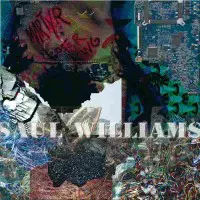My first inclination upon hearing MartyrLoserKing was to call it a very early candidate for hip-hop album of the year. But, the more I thought about it the more I realized this may be pigeonholing the album far too much. While Williams has always drawn heavily from hip-hop music and slam poetry in regard to his lyrics and lyrical delivery, his music has been anything but. His Rick Rubin produced debut, Amethyst Rock Star found him combining rock elements with hip-hop, The Inevitable Rise and Fall of Niggy Tardust! was produced by Trent Reznor and brought strong industrial influences into his sound, and he also made two more traditional albums in the form of his eponymous second album and the dance oriented Volcanic Sunlight. This album though finds Williams bring nearly all of these influences together, with the help of producer Justin Warfield, to make what may be the most cohesive album of his career.
Like most of Williams’’ work this album has a single underlying concept. This album is centered on a hacker utilizing the screen name MartyrLoserKing that is located in the East Africa country of Burundi. The album utilizes this character to examine protest in the digital age and hacking as a possible art form in and of itself.
The second track on the album, “Horn of the Clock-Bike†utilizes a piano loop that catches your of the bat, before Williams begins delivering his lyrics utilizing a delivery that harkens back to his debut as it is delivered more in the style of a slam poem before his own sung vocals cut in adding another layer to the music. Shortly after this, Williams delivers the line “statues as martyrs, hackers as artists†while just digging into the concept of hacking as a form of art it sets the tone for the album early on. Which is that, if art is distilling truth from the world around you then hacking is perhaps the greatest form of modern art?
In looking for this truth, Williams cannot turn a blind eye to the world he has been living in since he released his last album five years ago. Among these were the shooting deaths of Trayvon Martin, Michael Brown, John Crawford, and numerous others and the way many in the public dug for ways to prosecute these men for their own deaths. This is spoken to throughout the track “Ashes†which opens with a heavily distorted vocal singing, “Dancing on the corpses ashes†before Williams launches into another spoken word piece demonizing power/money hungry politicians, the media, and law enforcement for their immorality over the past several years. In a line that harkens back to the previously mentioned theme of hacking being art, Williams reminds us “Protect and serve, your bullets will not deliver the last word.†Before later reminding us that even though the court of public opinion may cast guilt on the men behind the guns, the court of law is not always operating on the same level, as he says, “the jury is hung from every museum ceiling.â€
“The Bear/Coltan as Cotton†continues to speak to the prevailing theme of hacking as a modern digital art form. The title also speaks to the harvesting of the element coltan/columbite-tantalite, which are used in a number of electronic devices in the form of tantalum capacitors, as creating a modern form of slavery on par with the cotton trade of the early-mid 1800’s. Lyrically, the track encourages everyone to hack into any accepted truths in their lives be them dietary, political, economic, or gender based. In doing so, he gives nods to both Edward Snowden and Chelsea Manning.
The overlying ethos of the album can be heard on “All Coltrane Solos At Once†in its refrain of “Fuck you, understand me.†This track with its complex look at developing an identity while maintaining some semblance of privacy in the digital age may be the first true commentary on what does and does not qualify as art. With the websites like Tumblr, YouTube, Twitter, and Instagram being widely utilized across society, especially by people under twenty-five, it has become easier than ever for someone to express themselves to a community of like-minded individuals without regard to time zones or even datelines. This has completely changed the standard ideas of things like performance spaces, audiences, and galleries beyond where they were just a decade ago. It also points to the issue that people in small localized art communities had decades and even centuries ago, which is where does the point between personal artistic expression and an artist’s private life exist.
As I stated in the opening, this was initially an early candidate for Hip-Hop Album of the Year. However, the more I listened to this the denser I realized the album was musically. It pulls from rock, punk, noise, industrial, hip-hop, and even African tribal music. Lyrically the album is among the first to take this kind of look at hacker culture as well as how the definition of the artist and art have changed in the digital age. Regardless of genre, this may well end up being one of the best and conceptually most important albums released this year. This is a heavy wager to place on an album that came out before the first month of the year had even drawn to a close, but one I make with confidence.Â
